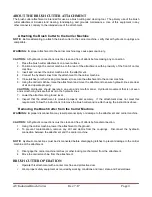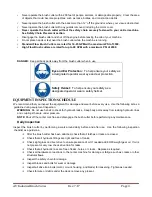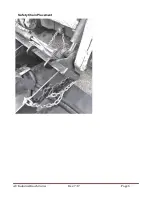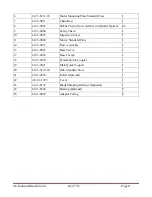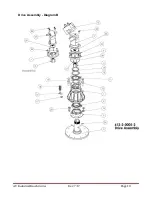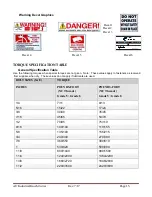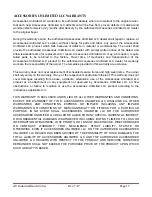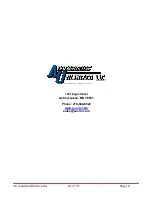
AU Industrial Brush Cutter
Rev. 7:17
Page 4
•
Never operate the brush cutter within 200 feet of people, animals, or damageable property. Clear the area
of objects that could become projectiles, such as rocks, bottles, and construction debris.
•
Never operate the brush cutter with the back more than
12” off the ground or where your view is obstructed.
•
Never operate the brush cutter with any guards removed, including the motor cover.
•
Never operate the brush cutter without the safety chain securely fastened to your carrier machine.
See Safety Chain Placement section.
•
Disengage the brush cutter and shut off the engine before leaving the cab of your machine.
•
Do not place hands or feet near the brush cutter while the machine is running.
•
Standard Flow Brush Cutters are rated for 16-25 GPM with a maximum PSI of 3500.
•
High Flow Brush cutters are rated for up to 60 GPM with a maximum PSI of 4500.
DANGER:
Keep all body parts away from the brush cutter when in use.
Eye and Ear Protection:
To help ensure your safety as
a designated operator wear eye and ear protection.
Safety Helmet:
To help ensure your safety as a
designated operator wear a safety helmet.
EQUIPMENT INSPECTION SCHEDULE
We recommend that you inspect the equipment for damage and wear before every use. Use the following list as a
guideline during equipment inspection.
WARNING:
Do not use hands to check for hydraulic leaks. Keep body parts away from leaking hydraulic lines
and couplings that are under pressure.
NOTE:
Shut off the
carrier machine and disengage the bush cutter before performing any maintenance.
Daily Inspection
Inspect the brush cutter by performing a walk around daily before and after use. Use the following inspection
checklist as a guideline.
After the brush cutter has been attached, check that all latches or locks are closed.
Check that all hydraulic fittings are tight and free of leaks.
Check sight glass on direct drive to ensure presence of oil. If needed add 80/90 weight gear oil. If oil is
not present or very low check drive train for leaks.
Check that all hydraulic lines are free of leaks, holes, or cracks. Replace as required.
Check all hardware connections to the carrier machine for damage or fatigue such as cracks or other
structural flaws.
Inspect the safety chain for damage.
Inspect blades and bolts for wear or damage
Inspect all drive train bolts (motor, mount, housing, and blade) for loosening. Tighten as needed.
Check for wire or debris under the deck, remove any present.




